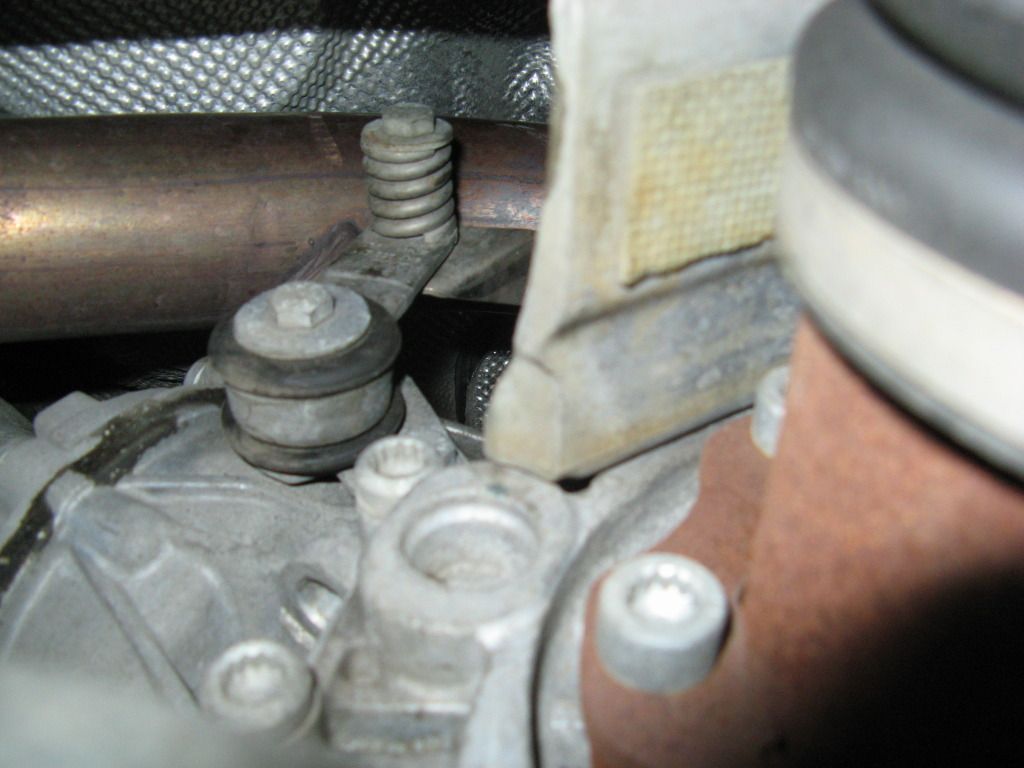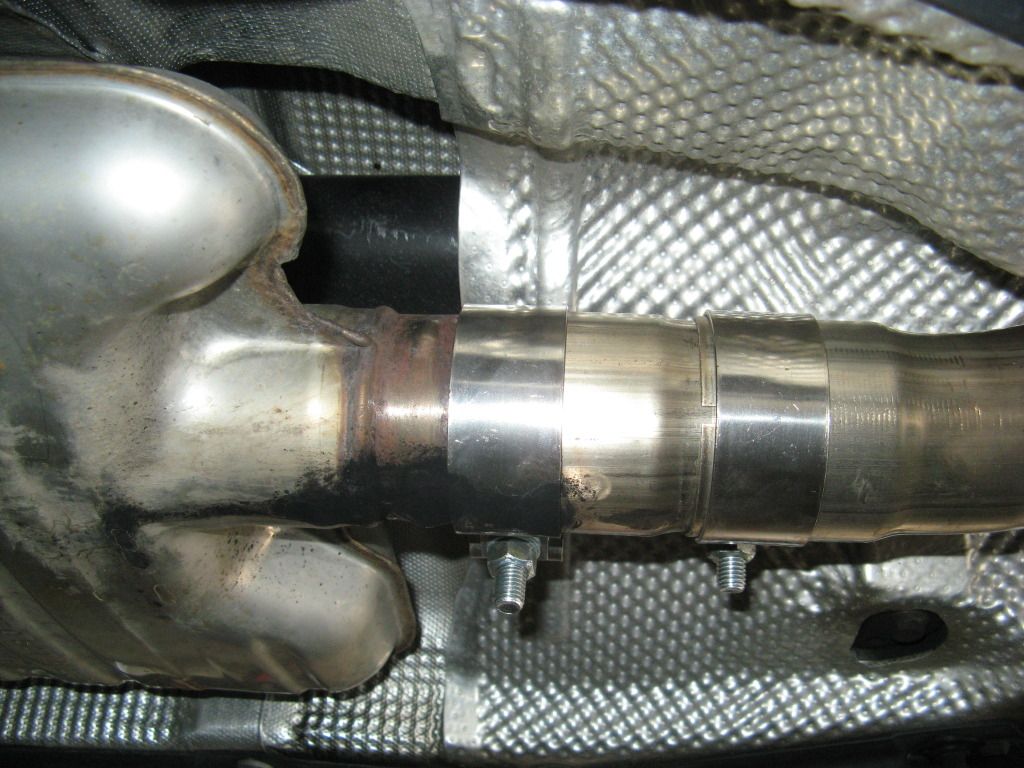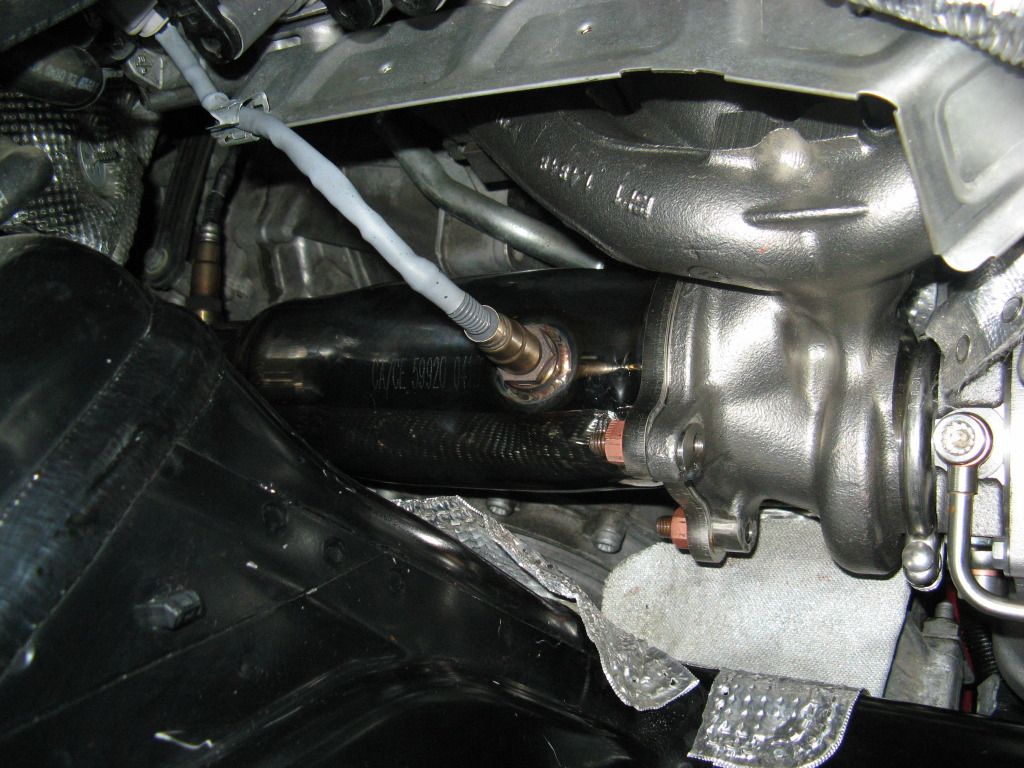Step 1: Remove the auxiliary cooling fan shroud. Remove the airbox. Remove the turbo inlet hose. This is what you’re left with.

Step 2: Disconnect both O2 sensors. The primary sensor wiring goes through a small clip on the exhaust manifold heat shield then the connector mates on a plastic bracket on the ignition coil harness assembly. The bracket and mating connector are shown below.

You can then remove the primary sensor using an O2 sensor tool.

The secondary O2 sensor is routed between the aft of the engine and the firewall. The connector mate is done on a bracket installed to the driver’s side of the transmission. The picture below shows after I de-mated the connection. I had to spray a little WD-40 on the bracket in order to slide the connectors out of the bracket since it was a tight fit. It’s easier to safely de-mate the connectors after you have them off the bracket. There are two zip ties you will have to cut that tie the sensor wire down onto other wiring harnesses. After you disconnect it all you can route the sensor wire back to the cat in preparation for removing it.

Step 3: Remove the three nuts you can get to that connect the cat to the turbo using a 15 mm wrench. Spray them all down with PB Blaster. The two on the passenger side are easy to reach. I was able to get the upper driver’s side bolt using a normal 15mm craftsman combination wrench by alternating using the box end and open end in different orientations. None of the nuts were very tight but perhaps that is because my car only has 36k miles on it. In another 5 years perhaps they will be a lot tougher. You can see the 3 that I was able to remove in the picture below.

Step 4: Remove the shock absorbing link assembly that connects the lower portion of the cat pipe to the engine. The lower bolt between the link and the engine will require a 12 mm combination wrench. The upper bolt (where the spring is) will require a 13 mm combination wrench from below to loosen the bolt and a 13 mm combination wrench from the top to hold the nut. You will need a helper from above to hold the nut because the way it is oriented you can't reach both sides and turning the bolt will just cause the nut to spin. When you reinstall this later you won't need a helper because the pipe is smaller and the bracket it mounts to is different so you will be able to reach both sides. Perhaps you can get the cat out with this link installed but the stock cat is a tight fit so I went ahead and removed it. You’ll need to remove it anyway once off the car because it will get installed to the new cat.

Step 5: Disconnect the downpipe from the midpipe. You can see my connection below. Midpipe is to the right, downpipe is to the left. I had just installed a new exhaust (aft of downpipe) two weeks earlier. I didn’t use exhaust paste at this joint because I knew I’d be taking it apart in a week or two to do this project. That is why you can see the black marks indicating some exhaust had been escaping at this joint. Both clamp bolts on mine were 15 mm. I can’t recall if the bolts from the stock exhaust were 15mm or not. You’ll need a deep well socket to get over the bolts and onto the nuts. Once the connection is loosened you’ll need to slide the downpipe forward (it isn’t going to move much) and the midpipe backward to get the slip fit connection apart. I couldn’t get enough space so I had to remove the muffler hanger bracket so that the exhaust could be slid back farther. You'll probably have to do the same thing. Spray the connection down with some WD-40 to get the two sliding a little easier against each other.

Step 6: Now you’ve got to get out the final nut holding the cat to the turbo. I rigged up the combination of sockets you see below and had a helper above help with getting the socket onto the bolt. The sequence was: 15mm deep well socket – swivel - 10” extension – swivel - 18” extension - 6” extension - ratchet. It would be damn near impossible to do this yourself. I suppose if you were stranded on a desert island and had a couple weeks to do this then you could probably do it yourself with only a 50:50 chance of hopelessly stripping the bolt. It took us a half dozen tries to get it on the nut securely but once it was on, the nut came right off.

Step 7: Now you can pull the downpipe rearward so that the connection between it and the cat can be reached. Hopefully you’ve been spraying copious amounts of PB Blaster on these three nuts ever since you started the install because the nuts are cheap and they will be completely seized in place. I only got one of the three to come off. I think they are 12 mm. The other two got completely stripped. I broke out the dremel and cut the two bolts off. The problem I then realized is that the bolts are pressed into the downpipe flange and tack welded in place. So I couldn’t just hammer them out. I had to cut them flush with the flange and then drill them out. Then get replacement hardware. It wasn’t too bad because you have easy access to the spot but it was still a pain. Hopefully you have better luck than me and hopefully your cat comes with new nuts so you don’t have to put these three crappy ones back on, thereby virtually eliminating any hope of ever de-mating this connection in the future.

Step 8: Now you should be able to wedge the cat out the top of the engine. It is a very tight fit with that secondary O2 sensor still installed, but it is so buried that you have no hope of getting it out with the cat in the engine bay. Just pull hard and get things oriented correctly and it will come out. Remove the secondary O2 sensor once you have it out of the engine bay.

Transfer the secondary O2 sensor and the shock absorbing link over to the new cat. Installation is the reverse of removal, except that you’ll have more space to work with because your new high flow cat or test pipe is way smaller in diameter than the stock cat. I think if you are installing a test pipe that you can actually get all four of the TP to turbo nuts on from the top of the car. You should have gotten two new gaskets for either end of the cat and those will go in during the reinstall. Here is what your finished product is going to look like. Now go get a tune and start taking solace in the fact that your car is no longer slower than a V6 Toyota Camry.














 Reply With Quote
Reply With Quote





Bookmarks